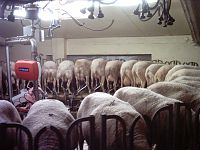
Photo from wikipedia
Systemic inflammation is common in early lactation dairy cows and is associated with decreased milk production. The Scutellaria baicalensis plant contains flavonoids with anti-inflammatory and anti-oxidative properties, which may counteract… Click to show full abstract
Systemic inflammation is common in early lactation dairy cows and is associated with decreased milk production. The Scutellaria baicalensis plant contains flavonoids with anti-inflammatory and anti-oxidative properties, which may counteract the inflammatory state in early lactation dairy cows. The objective of this experiment was to determine whether Scutellaria baicalensis extract (SBE), a source of bioactive flavonoids, would alter the adaptation to lactation. Multiparous Holstein cows (n = 122) were used in a randomized block design to determine the effect of short-term and long-term postpartum administration of SBE on 305-d milk yield, 120-d milk component yield, and early lactation milk markers of inflammation and metabolic function. Treatments were 1) control, 2) short term (5-d) administration of the SBE (SBE5), and 3) long term (60-d) administration of the SBE (SBE60). Treatments were included in a treatment pellet that was identical to a control pellet in ingredient source and composition except for the extract (10 g/d SBE providing 3.3 g/d of the flavonoid baicalin), both provided via an automated milking system beginning on d 1 of lactation. Milk samples were collected on d 1, 3, and once during d 5–12 of lactation, followed by weekly sampling until 120 days in milk (DIM). Milk samples collected in the first 2 wk were used for biomarker analysis (haptoglobin, β-hydroxybutyrate [BHB], and glucose-6-phosphate [G6P]), and all samples were used for composition analysis. Cows were body condition scored every 2 wk prepartum and postpartum. Milk production, programmed pellet allocation, and actual provision of both pelleted feeds were recorded daily. Treatment effects were evaluated by contrasts between control and SBE5 and control and SBE60 for both the treatment (TP; wk 1–9) and carryover periods (CP; wk 10–37). Total pellet offered was greater for SBE60 in both the TP (P < 0.01) and CP (P = 0.02) but was not different for SBE5 during either period (P ≥ 0.13). No treatment effects were observed for body condition score (BCS), milk haptoglobin, BHB, or G6P. SBE5 did not alter milk yield or milk components. SBE60 increased whole-lactation milk yield by 1,419 kg (13%; P = 0.03). SBE60 increased milk lactose and fat yields (P ≤ 0.04) and tended to increase milk protein yield (P = 0.09) during TP, and each increased during CP (P ≤ 0.04). Somatic cell count decreased by 10% in SBE60 during TP (P = 0.02) but not CP (P = 0.13). Mastitis incidence tended to differ by treatment, being lesser for both SBE5 and SBE60 vs. control (14 and 15% vs. 33%). SBE supplementation did not impact time to pregnancy or hazard of leaving the herd. In conclusion, despite no detected treatment effects on BCS or milk biomarkers of inflammation and metabolic status, supplementation of postpartum dairy cows with Scutellaria baicalensis extract for 60 d was effective at increasing whole lactation milk yield.
Journal Title: PLoS ONE
Year Published: 2019
Link to full text (if available)
Share on Social Media: Sign Up to like & get
recommendations!